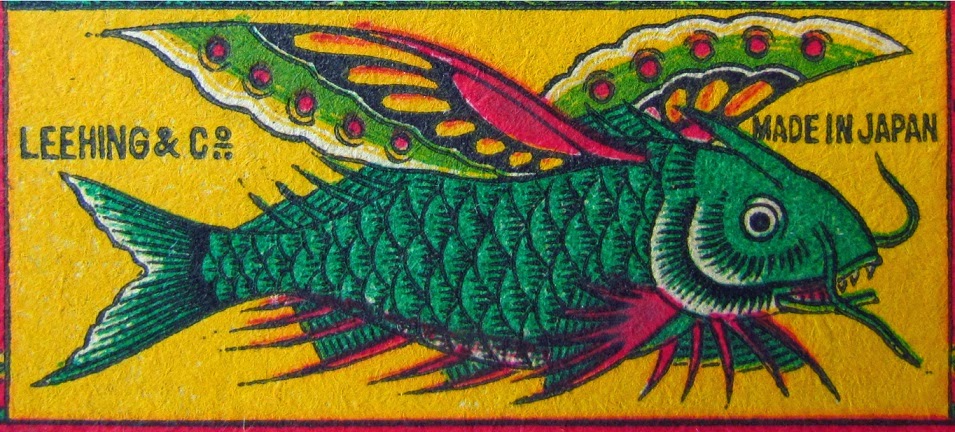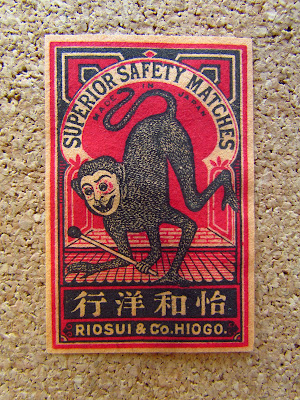The minogame (蓑亀), which is so old it has a train of seaweed growing on its back, is a symbol of longevity and felicity. A minogame has an important role in the well-known legend of Urashima Tarō.
According to traditional Japanese beliefs, the tortoise (turtle) is a haven for immortals and the world mountain, and symbolizes longevity, good luck, and support. It is the symbol of Kumpira, the god of seafaring people.
The tortoise is a favored motif by netsuke-carvers and other artisans, and is featured in traditional Japanese wedding ceremonies. There is also a well-known artistic pattern based on the nearly hexagonal shape of a tortoise’s shell. These patterns are usually composed of symmetrical hexagons, sometimes with smaller hexagons within them.
Leehing

Monday, May 28, 2012
Saturday, May 26, 2012
Wednesday, May 23, 2012
A Japanese website of Kyoto Yamamoto's collection of many old beautiful Japanese Trade Mark labels
Kyoto Yamamoto's Japanese Trade Mark labels
(every photo is a link to other labels on the same subject)
 |
| Got it! |
Copyright © 2005 kyoto-yamamoto All rights reserved.
Sunday, May 20, 2012
Collectors' websites
The Yecheal Biskovits Match Collection's website
Yecheal has been collecting Japanese match box labels since 1997. He has a huge collection of Japanese trade mark match box labels, woodblock printed match labels, Japanese match safes, match holders, matchbook holders, and basically anything related to the Japanese match industry.
The Mission of Dr. Utpal Sanyal, Ph.D.
Dr. Utpal is a collector from India who collects Stamps, Matchbox, Coins & Notes, Birds nest and Origami. Most of his collections are related to his mission: Fight against Cancer, Tobacco Use, AIDS and Encouraging Blood Donation.
The Matchbox Museum of Shakil Huq
Shakil is from from Bangladesh. He is an artist, amateur photographer and a collector of bank note, matchboxes, empty toothpaste packet and anything vintage.
The World Of Matchboxes, Matchbooks & Matchbox Labels of Manoj Sonalkar
Manoj is my first Facebook's friend. He is from Pune, Maharashtra, India. He is a collector of matchboxes, labels, skillets, matchbooks. He is also an amateur photographer that always experiments with his camera.
Bob Jacobs Home Page
Bob is from The United Kingdom, and he has approximately 35,000 items (mostly matchbox labels) in his collection, which have been gathered over a period of 44 years from all parts of the world.
The Blog of Joel Gabriels
Joel is a collector from Belgium who collects Matchbox labels, Matchbox Holders, old Matchboxes, Postcards related to Phillumeny etc.
The website of Flemming Henningsen
Flemming is from Denmark. He has been collecting matchboxes and labels since childhood, back in the sixties. His collection now contains more than 100,000 different items from 123 countries.
The website of Bjorn Stenberg who collects some very old labels from Sweden (includes the AMAZING collection of very old wooden matchboxes of Mick Lilley)
The showcasephillumeny collections of Ratnadeep Mondal
Ratnadeep collects Indian stuff. He and his father had actually started collecting matchboxes around late eighties. For around 12-15 years the album was tucked away in their store room and nothing substantial was added to our collection, but recently his interest has renewed and he is back on the streets on his Phillumenic journey.
Thursday, May 17, 2012
19th century Round cilinder matchboxes of Scheinost and Pojatzi - All right reserved to http://www.antico.be
 |
Lumiferi N° 2 senza zolfo -
Fl. Pojatzi & Comp. Styria
Made in Austria
|
 |
Fabrico especial para o Brazil
- pojatzi comp. Styria . |
 |
| A. Scheinost schuttenhofen
Made in Czechoslovakia
|
 |
| Umiferi N°2 senza zolfo. Scheinost .
Made in Czechoslovakia
|
 |
Alumettes imperiales - Vojtech Scheinost.
Made in Czechoslovakia (Full box) Susice - Cechy . |
 |
Fabrico especial para o Brazil -
Made in AustriaFl. pojatzi comp. Styria. |
 |
| A. Scheinost. schuttenhofen. Made in Czechoslovakia |
Aren't they lovely pieces of art? (but very expensive...)
Tuesday, May 15, 2012
Monday, May 14, 2012
I love Elephants !
The Symbolism of the Elephant In Hindu and Buddhism tradition (source: http://acropolis.org.in/articles/162-the-symbolism-of-the-elephant) |
The elephant, in its most global and universal meaning, symbolizes strength and power, not only physical but also mental and spiritual.
In Hindu tradition, elephants call up the image of Ganesha, symbol of knowledge, son of Shiva and Parvati. His human body is the microcosm, manifestation, and his elephant’s head is the macrocosm, non-manifestation. He is the beginning and the end. During processions, elephants were ridden by kings and foremost by Indra, King of the Heavens, thus symbolizing royal power. In the Far East, the elephant’s round and massive body as well as its whitish-grey colour lead to it being a representation of clouds. Hence the myth of the purported existence of winged elephants believed to constitute the cloudy skyline. In Siam, Laos and Cambodia, the white elephant grants rainfall and plentiful harvests. But when ridden by Indra, Lord of the Heavens, the elephant becomes the Storm-God.
The elephant also plays the role of the animal that holds up the world. Elephants are the “caryatids” of the universe. They possess in themselves the structure of the cosmos: their structure is composed of four pillars supporting the celestial sphere, symbol of stability and immutability.
Yoga associates the elephant to the chakra Mûlâdhâra, in turn associated with the element Earth and the mastery of the centre upon the four directions of terrestrial space. With respect to the Tree of Life, uniting Heaven and Earth, the elephant is found at the top, from where stems Light enlightening the world from the peak down to the valley. Its feet and its trunk, shaped like an “S”, are in contact with the ground while its two ears, on another symbolic plane, correspond to the two blades of the double-edged axe of ancient Cretans.
According to Buddhist teachings, Queen Maya conceived the Buddha from an elephant calf that caressed her body with its trunk while she was asleep. In this way, the elephant calf is seen as the instrument of Heaven’s action and blessing that will give birth to the Avatar.
Its strength allows whoever invokes the power of the elephant to realize his heart’s desires. When one wishes to begin an important endeavour, the elephant is invoked as God of Knowledge and destroyer of obstacles, under the appearance of Ganesha. It is also invoked at the beginning of Buddhist prayers.
When placed on top of a pillar, an elephant evokes the Light of Knowledge. Finally, the Boddhisattva rides an elephant as a display of the power of knowledge, which can awaken man to the consciousness of his own destiny.
Copyright © 2012 New Acropolis India North Cultural Organization. All Rights Reserved.
Mitsui Bussan Kaisha - a Japanese Shipping company. Mitsui Bussan Kaisha was established in 1876 and obtained exclusive rights to export and market the coal mined at the state-run Miike mines, as well as Matchboxes and related.
On 1896 (Meiji 29) Naoki matches first exported to Singapore with association of Mitsui Bussan. This was the first experience for a Japanese company to export Japan made matches. (source: http://www.match.or.jp/english/history/history01.html)
Subscribe to:
Posts (Atom)



















E7swBPwegIEK3Q~~60_58.jpg)


Yg~~60_58.jpg)




















